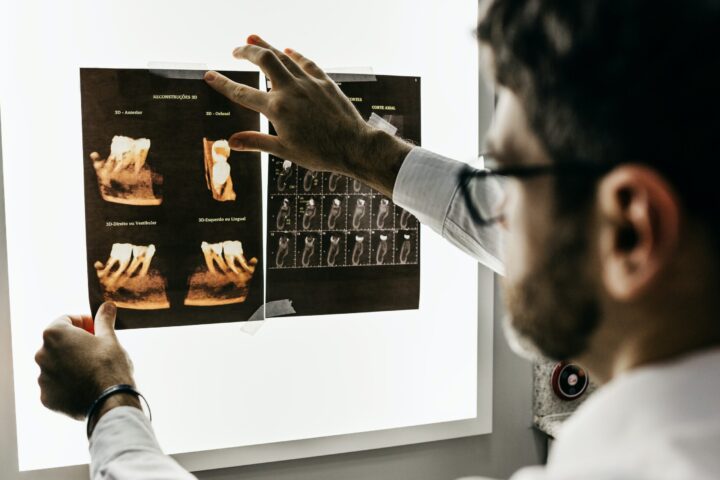Early detection of diseases is critical in healthcare. Identifying a disease in its initial stages often means that treatment can be more effective, less invasive, and affordable. However, catching diseases early has traditionally been a challenge due to various factors, such as the subtlety of early symptoms and the limitations of human analysis.
This is where Artificial Intelligence (AI) steps in. AI is becoming a game-changer in healthcare, particularly in early disease detection. In this comprehensive discussion, we will explore the role of AI in early disease detection, covering various aspects of how AI is applied, the specific diseases it helps detect, the benefits and challenges of using AI, and the future potential of this technology.
Understanding AI in Healthcare
Before diving into its role in disease detection, it’s important to understand what AI is and how it functions in the healthcare sector.
AI refers to computer systems designed to perform tasks that normally require human intelligence. These tasks include learning from data, recognizing patterns, and making decisions. In healthcare, AI can process and analyze vast amounts of data, such as medical records, images, and genetic information, to identify patterns that might not be immediately obvious to human doctors.
AI systems learn from this data through a process known as machine learning. Machine learning is a subset of AI where algorithms are trained on large datasets. These algorithms learn to recognize patterns and make predictions based on the data they have been fed. For example, if an AI system is trained on thousands of images of healthy and diseased tissue, it can learn to distinguish between the two and predict whether a new image shows signs of disease.


AI and Early Disease Detection: How It Works
The primary goal of using AI in early disease detection is to identify signs of illness before they become apparent to patients or healthcare providers. Here’s how AI achieves this:
- Data Analysis: AI systems can analyze vast amounts of medical data at an incredible speed. This includes everything from medical images (like X-rays and MRIs) to lab results and patient histories. By analyzing this data, AI can detect patterns that indicate the early stages of a disease.
- Pattern Recognition: One of AI’s strengths is its ability to recognize patterns in data. For example, AI can detect small changes in a patient’s health that may go unnoticed by doctors. These changes could be early signs of conditions like cancer, heart disease, or diabetes.
- Predictive Modeling: AI can use the data it analyzes to make predictions about a patient’s future health. For example, AI can predict whether a patient is at risk of developing a certain disease based on their current health data and genetic information. This allows for early intervention, which can prevent the disease from developing or becoming more severe.
- Continuous Monitoring: AI systems can continuously monitor a patient’s health through wearable devices and other sensors. These devices collect data on vital signs, physical activity, and other health indicators. AI can analyze this data in real-time to detect any changes that may indicate the onset of a disease.
Specific Applications of AI in Early Disease Detection
AI is being used to detect a wide range of diseases early. Here are some of the key areas where AI is making a significant impact:
1. Cancer Detection
Cancer is one of the leading causes of death worldwide, but early detection can significantly improve the chances of successful treatment. AI is being used in various ways to detect cancer early:
- Breast Cancer: AI algorithms are used to analyze mammograms, the standard imaging test for breast cancer. These algorithms can detect tiny abnormalities in breast tissue that might indicate the presence of cancer. Studies have shown that AI can sometimes detect cancer earlier and more accurately than human radiologists.
- Lung Cancer: AI is also being used to detect lung cancer at an early stage. For instance, AI systems can analyze CT scans of the lungs to identify small nodules that may be cancerous. Early detection of lung cancer is crucial because the disease is often not diagnosed until it has reached an advanced stage.
- Skin Cancer: Dermatologists are using AI to analyze images of moles and other skin lesions to determine whether they are cancerous. AI systems can compare a patient’s skin lesion images with a vast database of images to identify those that are likely to be malignant. This can lead to earlier diagnosis and treatment of skin cancer.
2. Cardiovascular Disease Detection
Heart disease is another leading cause of death, and early detection is key to preventing heart attacks and other serious complications. AI is being used in several ways to detect cardiovascular diseases early:
- Heart Imaging: AI can analyze images from echocardiograms, which are ultrasound images of the heart. By analyzing these images, AI can detect early signs of heart disease, such as abnormalities in the heart’s structure or function.
- Electrocardiograms (ECGs): AI can analyze ECGs, which record the electrical activity of the heart. AI systems can detect irregular heartbeats (arrhythmias) or other issues that may indicate the early stages of heart disease. In some cases, AI has been able to detect heart problems that were missed by human doctors.
- Wearable Devices: AI-powered wearable devices, such as smartwatches, can monitor heart rate, blood pressure, and other vital signs in real-time. These devices can alert users and their doctors to potential issues, allowing for early intervention.
3. Diabetes Prediction and Management
Diabetes is a chronic condition that affects millions of people worldwide. Early detection and management of diabetes are crucial for preventing complications such as heart disease, kidney failure, and blindness. AI is playing a key role in this area:
- Predicting Diabetes Risk: AI can analyze a person’s genetic information, lifestyle factors, and medical history to predict their risk of developing diabetes. This allows for early intervention, such as lifestyle changes or medication, to prevent the disease from developing.
- Monitoring Blood Sugar Levels: For people with diabetes, AI-powered devices can continuously monitor blood sugar levels. These devices can predict dangerous spikes or drops in blood sugar and alert the user to take action. This helps in preventing complications and managing the condition effectively.
- Diabetic Retinopathy: AI is also being used to detect diabetic retinopathy, a condition that can lead to blindness if not treated early. AI systems can analyze images of the retina to detect signs of this condition, allowing for early treatment.
4. Neurological Disease Detection
Neurological diseases, such as Alzheimer’s disease and Parkinson’s disease, are challenging to diagnose early. However, AI is making strides in this area:
- Alzheimer’s Disease: AI can analyze brain scans and other data to detect early signs of Alzheimer’s disease. For example, AI can identify subtle changes in brain structure or function that may indicate the onset of the disease. Early detection allows for interventions that can slow the progression of the disease.
- Parkinson’s Disease: AI is being used to detect Parkinson’s disease at an early stage by analyzing data from wearable devices. These devices can monitor a person’s movements and detect changes that may indicate the early stages of Parkinson’s. This allows for early diagnosis and treatment, which can improve the quality of life for patients.


The Benefits of AI in Early Disease Detection
The use of AI in early disease detection offers numerous benefits, which include:
1. Speed and Efficiency
One of the most significant advantages of using AI in early disease detection is speed. AI systems can analyze large amounts of data quickly, providing results in a fraction of the time it would take a human doctor. This means that diseases can be detected earlier, and treatment can begin sooner. For example, analyzing a CT scan or MRI might take a radiologist several hours, but an AI system can do it in minutes.
2. Accuracy and Precision
AI systems can analyze data with a level of precision that is difficult for humans to match. This is particularly important in early disease detection, where small details can make a big difference. AI can identify subtle changes in medical images or detect patterns in data that might go unnoticed by a human. This leads to more accurate diagnoses and reduces the risk of misdiagnosis.
3. Scalability
AI systems can be used to screen large populations for diseases, even in areas with limited healthcare resources. For example, AI can be used to screen thousands of people for tuberculosis or malaria in developing countries. This makes it possible to identify cases early and prevent the spread of these diseases.
4. Cost-Effectiveness
By detecting diseases early, AI can help reduce healthcare costs. Early detection often means that treatment is less expensive and less invasive. For example, catching cancer early might mean that a patient only needs surgery, rather than more expensive treatments like chemotherapy or radiation.
5. Personalized Healthcare
AI can analyze a person’s genetic information, lifestyle factors, and medical history to create personalized healthcare plans. This allows for early intervention and treatment that is tailored to the individual, increasing the likelihood of successful outcomes.


The Challenges of Using AI in Early Disease Detection
While AI offers many benefits, there are also significant challenges that must be addressed:
1. Data Quality and Quantity
AI systems rely on large amounts of high-quality data to function effectively. If the data is incomplete, inaccurate, or biased, the AI’s predictions might be wrong. This can lead to misdiagnosis or missed diagnoses. Ensuring that AI systems have access to accurate and representative data is crucial.
2. Bias and Fairness
AI systems can sometimes produce biased results if they are trained on biased data. For example, if an AI system is trained on data from one demographic group, it might not work as well for people from other groups. This can lead to unequal healthcare outcomes. It’s important to ensure that AI systems are trained on diverse and representative datasets to avoid bias.
3. Transparency and Trust
For AI to be widely adopted in healthcare, patients and healthcare providers need to trust the technology. This means that AI systems need to be transparent, with clear explanations for their decisions. Healthcare providers need to understand how AI makes its predictions so that they can use the information effectively in their decision-making.
4. Regulation and Oversight
The use of AI in healthcare is still relatively new, and regulatory frameworks are still being developed. It’s important to have clear guidelines and standards to ensure that AI systems are safe and effective. Additionally, there needs to be oversight to ensure that AI is used ethically and that patient data is protected.
5. Integration with Existing Systems
Integrating AI into existing healthcare systems can be complex and costly. Healthcare providers need to invest in the necessary infrastructure and training to use AI effectively. This includes ensuring that AI systems are compatible with existing electronic health records and other healthcare technologies.


The Future of AI in Early Disease Detection
The future of AI in early disease detection is promising, with many exciting developments on the horizon:
1. Advanced Predictive Modeling
As AI technology continues to improve, we can expect even more advanced predictive modeling. AI systems will be able to analyze even more data, including genetic information, environmental factors, and lifestyle data, to predict a person’s risk of developing diseases with greater accuracy. This will allow for earlier and more personalized interventions.
2. AI-Driven Drug Discovery
AI is also being used in drug discovery, which can have a significant impact on early disease detection. By analyzing large datasets of chemical compounds and biological information, AI can identify potential new drugs that can be used to treat diseases at an early stage. This could lead to the development of more effective treatments for diseases that are currently difficult to treat.
3. Telemedicine and Remote Monitoring
The rise of telemedicine and remote monitoring is creating new opportunities for AI in early disease detection. AI-powered devices can monitor patients’ health in real-time, even when they are at home. This data can be analyzed by AI to detect early signs of disease, allowing for timely intervention without the need for in-person visits.
4. AI in Preventive Healthcare
AI is also expected to play a larger role in preventive healthcare. By analyzing a person’s health data, AI can identify risk factors for diseases before they develop. This will allow healthcare providers to recommend lifestyle changes, medications, or other interventions to prevent the disease from occurring.
AI is revolutionizing early disease detection, offering speed, accuracy, and the potential to save lives. By analyzing vast amounts of data, recognizing patterns, and making predictions, AI can detect diseases at an early stage, when they are most treatable. This has the potential to significantly improve healthcare outcomes and reduce healthcare costs.
However, the use of AI in early disease detection also comes with challenges. Ensuring data quality, avoiding bias, building trust, and developing clear regulations are all crucial to the successful implementation of AI in healthcare. As AI technology continues to advance, we can expect even more exciting developments in early disease detection.
The future of healthcare is likely to be increasingly AI-driven, offering new opportunities for early intervention and personalized treatment. With continued research, collaboration, and ethical considerations, AI has the potential to transform healthcare and improve the lives of millions of people around the world.



































you will have a terrific weblog here! would you prefer to make some invite posts on my weblog?